 RAN Light Fleet Aircraft Carrier (R21), ex-HMS Majestic (1942-82)
RAN Light Fleet Aircraft Carrier (R21), ex-HMS Majestic (1942-82)
Australia Day !
HMAS Melbourne (R21) was a Majestic-class light aircraft carrier, modified to be operated by the Royal Australian Navy (RAN), from 1955 to 1982. She was the third and last Australian aircraft carrier with the reputation of having sank two friendly warships in peacetime collisions. But she started as the lead ship of the class, HMS Majestic (R77), laid down in April 1943, launched in February 1945 but work was suspended until purchased by the RAN in 1947. It was decided to complete her on an upgraded jet-capable angled deck design but delays meant a commission reported to 1955. Nevertheless, as part of the Strategic Reserve she had a relatively uneventful career with the sole combat action distinction of Malaysia 1965–66. #coldwar #RAN #royalaustraliannavy #melbourne #hmasmelbourne #aircraftcarrier #fleetcarrier
Genesis: The RAN two-carriers fleet (1948-1973)
Background of HMAS Sydney and Melbourne
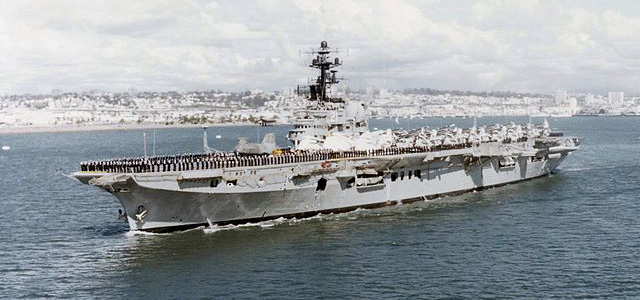
HMS Melbourne in San Diego. Unlike her sister Sydney she never saw action in Vietnam.
In 1944, the Australian government already proposed to the RN a full Austrlian crew to relieve a British one as a Royal Navy rapidly expanded, and notably aboard an aircraft carrier, two cruisers and six destroyers. The Admiralty agreed to man an upcoming Colossus-class Light Fleet carrier when completed and this was to be HMS Venerable, directly under RAN supervision for free or loan, in recoignition to this Commonwealth country massive contribution on many front and at sea. Australia reviewed manpower requirements and started to reserve the personnel needed, which started training. However by mid-1945, the RAN changed course as with Victory in Europe, the Royal Navy started to be reduced and refocused in the Pacific. Emergency being over, the RAN staff offered to purchase HMS Ocean for its own end war or postwar needs. June, PM John Curtin however vetoed this, preoccupied by expected budget cuts. In July Ben Chifley revised this but the war ended in between.

HMS Vengeance underway in 1945. She was the first RAN carrier.
Post-war reassessment of RAN needs led to a generous plan to acquire no less than three aircraft carriers and create task forces in charge of Southern waters, Indian Ocean, and South Pacific, around which the fleet would be organized. Postwar fundings opposed these optimistic naval staff requirements and this was revised to two carriers, north and east coast fleets. Al agreed these would be the next Majestic-class vessels, knowing their cost would be cheaper due to Britain’s own budget restrictions and will to sell thee surplus hulls as soon as possible. HMS Terrible was selected first followed by the lead ship HMS Majestic. However the first became a mildly modernized vessel as HMAS Sydney, while the second would gbet the “full jet upgrade”, which postponed its completion for years later. In the meantime, HMS Vengeance was loaned from 1952 to fill this naval plan, until Melbourne was ready, keeping the two-carrier fleet a reality and assuming training, despite the obsolescence of the Vengeance.
Origin: 1942 Design Light Fleet Carrier
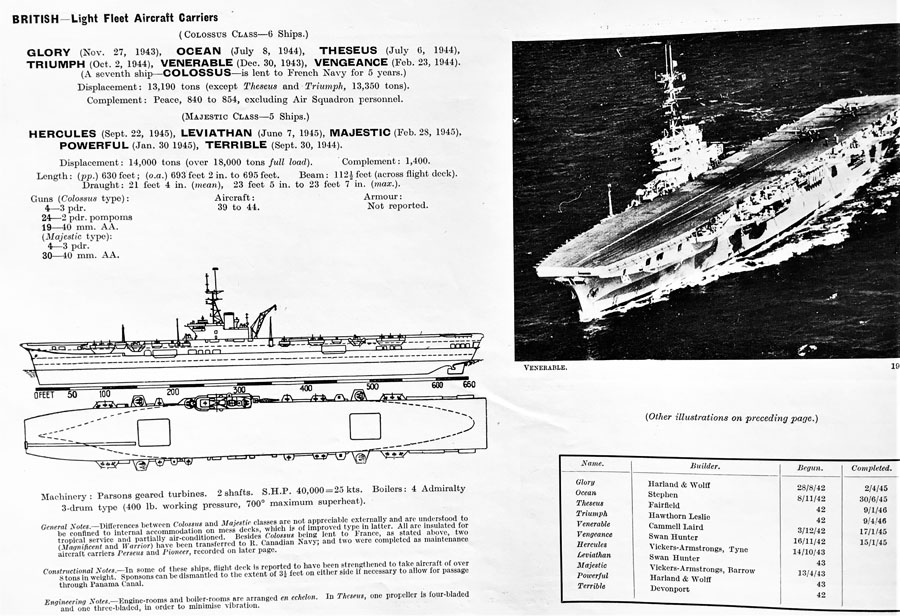
ONI summary of the colossus class
HMAS Melbourne was one of the six Majestic-class light fleet carriers, which were modified Colossus with reinforced flight deck and lifts, better catapult, a bit roomier. This superclass which was to include later the Centaurs were all seen as expandable civilian-grade and built much simplified and unprotected aicraft carriers. In the grand scheme of things, they were to be used as éiacraft refiller” in the second line behind a first line made of armoured carriers. All these ships were also meant to reinforce the British Pacific Fleet but only the first four of the Colossus class managed to see WW2.
The rest of the class as well as the Majestics and Centaurs were delayed and not completed but after the war, whe the new government looked as selling these at low price as they became all surplus to requirement, placed on reserve, reconverted or outright scrapped after a few years. More so, they were no longer tailored for the new jets, and costly modifications were expected, not seen favourably with the new labor government. A wave of international purchases implied many new customers, among which former Commonwealth members which made a considerable fleet buildup during the war: Canada was the first of these “happy customers” with HMCS Magnificent.
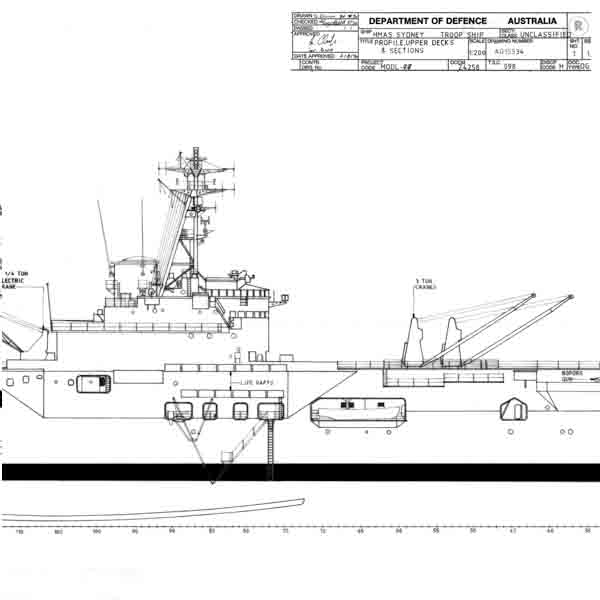
HMAS Sydney as troopship, plan extract
The Colossus of at large, 1942 “light fleet carriers” were a Vickers project, which already designed the famous Illustrious class armored carriers. The admiralty totally entrusted their design teams to solve the difficult requirements of building an aircraft carrier in civilian yards. This was one of the most complex ship imaginable, but yet, the same yards proved they have been able to ramp up their game considerably. Depending on their size and abilities, they were trusted to built at first the small Flower class corvettes based on a whaler, the properly military River class ASW frigates which went to serve for decades in the cold war, and it was though that carriers were still manageable as unlike battleships, cruisers or destroyers, mixing protection, various layers or armaments and sensors, a simple unprotected carrier could be undertaken in the large shipbuilders of the nation.
Those accustomed to tankers, freighters and passenger liners. The latter were eager for this anyway as the “cake” was generous: Sixteen were planned by the British admiralty, this was an unprecedented effort for any European Nation. The eight yards concerned were not all “pure” civilian, but as Harland & Wolff (Irish yard of Titanic fame) sharing the bulk of the order with Vickers-Arsmtrong, as well as Stephen & Sons. The other were of mixed experience, but only acustomed to lighter vessels: Cammell Laird, Swan Hunter, Fairfield, Hawthorne Leslie and later HM Dockyard Devonport for the Majestic ships.
Construction
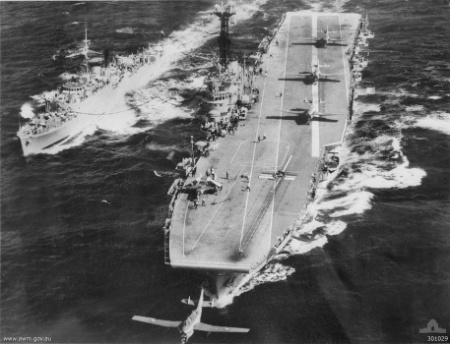 HMS Majestic (R21) was built at the Vickers-Armstrongs, Barrow-in-Furness Yard, which was the lead designer of the class. HMS Majestic experienced delays in construction between labour shortages in 1944, and delayed equipment, but also additional requirements made on the fly for Australian operations while construction of merchant ships was still a priority. by 1946, new systems and enhancements saw its acquisition cost soaring, to reach in 1954 AU£8.3 million, causing concerns of cancellation. Fitting out did was completed by October 1955. A commissioning crew was formed in Australia meanwhile, and crewed Vengeance to return her to the United Kingdom and make the swap on Majestic.
HMS Majestic (R21) was built at the Vickers-Armstrongs, Barrow-in-Furness Yard, which was the lead designer of the class. HMS Majestic experienced delays in construction between labour shortages in 1944, and delayed equipment, but also additional requirements made on the fly for Australian operations while construction of merchant ships was still a priority. by 1946, new systems and enhancements saw its acquisition cost soaring, to reach in 1954 AU£8.3 million, causing concerns of cancellation. Fitting out did was completed by October 1955. A commissioning crew was formed in Australia meanwhile, and crewed Vengeance to return her to the United Kingdom and make the swap on Majestic.
She was commissioned as “HMAS Majestic” indeed at first on 26 October and on the 28th, renamed Melbourne by Lady White (wife of Sir Thomas White, Australian High Commissioner to UK), leading to a second, proper commissioning ceremony. She was to be the most modern carrier Australia ever had, and last one until the Camberra class LHDs built in the 2000s.
Design of HMAS Melbourne

Blueprint of the class (here, FS Arromanches)
HMAS Melbourne was essentially a Majestic class design, already made with improvements over the Colossus class, and completely modernized. She was the third British angled carrier as completed, and integrated the best features in order to operate heavier aircraft and early jets, which size and weight were still compatible. Modifications were based on wartime experience but also the best of British carrier warfare innovations.
Hull and general design
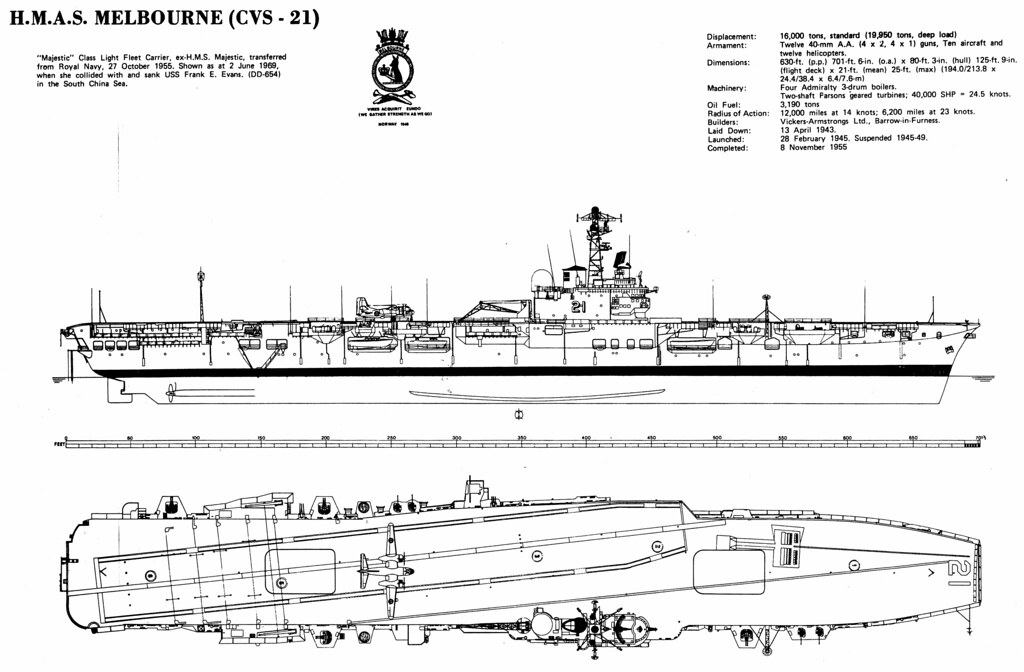
Plans
The centerpriece of the new design was an angled flight deck and a new steam catapult tailored for heavier aircraft as well as the lated technology of mirror landing aid. Melbourne was the third to get this package after HMS Ark Royal and USS Forrestal. She displaced as standard 15,740 long tons (17,630 short tons) and fully loaded 20,000 long tons (22,000 short tons) for an overall lenght of 213.97 m (702 ft) and with an added 2.43 m (8 ft) in 1969 on the forward catapult ramp extension. Beam was unchanged at 24.38 m (80 ft) but she reached 38.4 m (at the flight deck) and draught was heavier at 7.62 m (25 ft). To compare, HMAS Sydney displaced 14,000/16,000 tons, was a bit shorter, and had a 7 meters draught.
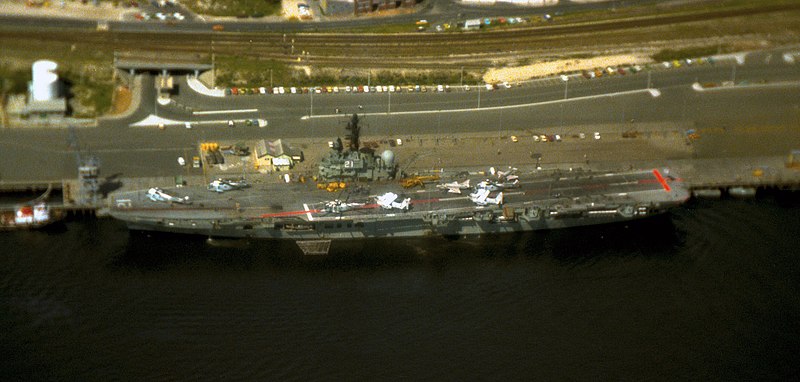
Overhead view in Fremantle, 1980
To operate jet aircraft, larger and heavier this flight deck was angled to 5.5 degrees from the centreline, and with proper deck parking this created a space for simultaneous launch and recovery. The deck gained a modest acre (4,000 square metres, 4,800 square yards) and was quite smaller compared to US designs, notably the Essex and more so, the first supercarriers in construction at the time. One model looked for was the S-2 Tracker, a twin-engine ASW patroller that was with 22.12-metre (72 ft 7 in) in wingspan and very tight clearance starboard wit the wingtip when landing. Dangerously close to the island. This required good wind conditions and skilled pilots. In fact USN pilots refused to land on her. Her island by the way was still relatively similar to other Majestic’s, albeit with a protruding admiral bridge, and navigation bridge above. She also had a unique lattice mast and whip aerials to carry her radars. After 1969 she had new radars with prominent radomes, notably aft of the island (see later).
Still, this flight deck as well as the original hangar deck and aircraft lifts were all much strengthened. To follow, a set of six reinforced arrestor cables were installed, four behind the aft lift, one above, one forward. As for the island, which was also modified, a flight direction radar was installed and this made her the only regional carrier able to operate at night or by poor weather. One unforeseen aspect was the high fresh water consumption of the large port steam catapult and propulsion, leading to Water rationing in operation.
As for protection it was added during completion and made for mantlets around aircraft torpedoes warheads rooms. They were only 10mm thick (0.39 in). Longitudinal watertight bulkheads were installed above the machinery spaces and that was it. The 1942 fleet carriers, originally built to civilian standards, were not well protected unlike the Illustrious and Indefatigable class, true armoured carrier made for the frontline.
Powerplant
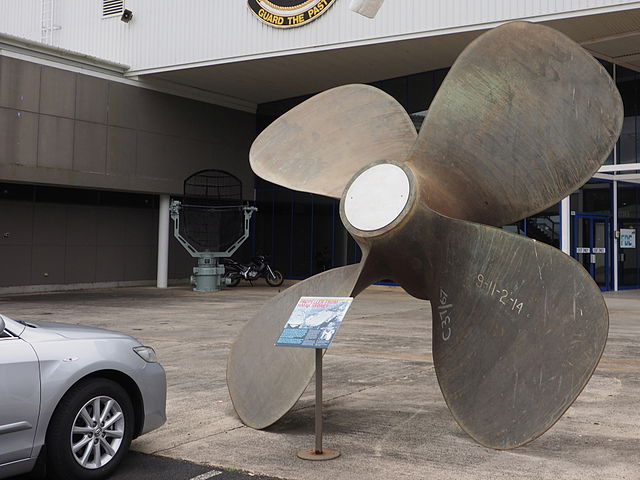
Propeller from HMAS Sydney at the FAA Museum, February 2015
HMAS Melbourne came with the standard two shafts, Parsons single reduction steam turbines, fed by two Admiralty 3-drum boilers for 40,000 shp (30,000 kW) total. Other sources states 42,000 shp,
and 24 knots. She carried less fuel oil as HMAS Sydney, 3200 versus 3480 tons, probably because of extra space taken by larger aviation gasoline tanks. Endurance was the same at 12,000 nautical miles at 14 knots, and top speed reputed to be light on trials, up to 24.8 knots (45.9 km/h; 28.5 mph), Her powerplant was never overhauled until 1982 and maintenance was helped by the numerous ships of that class still in activity around the globe.
Armament
HMAS Melbourne was to be at first completed with a gun-only defensive armament of seven twin 40mm/60 Mk 5 Bofors and eleven single 40mm/60 Mk 7 Bofors. With a modern fire control this was still seen as acceptable. In 1968 after refit, what remained of Bofors was retired, and she gained a new sensor suite: LW-02, ZW, SPN-35 radars and an ECM equipment.
Before 1968 this was 6 twin, 9 single and until 1980 4 twin, 4 single and after 1980 until decommissioned 4 single. In 1971 for her last refit, the catapult was replaced by a stronger one and the deck was strengthened again. But this was for a short time as she was placed in reserve already in 1976.
Sensors
She carried at first three radars: The type 277Q, type 293Q, and type 978 until her 1968 refit.
Type 277Q: Three Type 277Q height-finding set were installed.
Type 283Q: No info yet
Type 978: No info yet
Facilities
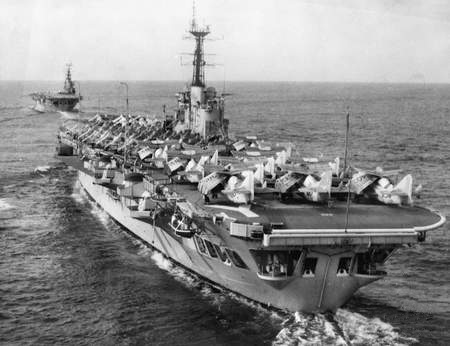 Her flight deck measured 210.3 x 24.4m (690 x 80 ft) for a total of 5,131m² ha or 2,142m² (23,056 Sqm) in surface. Her uninterrupted hangar ran over 135.6 m (445 ft) in lenght, for 15.8 meters wide (51 ft) with only and 5.3 m to spare in height (17 ft). In volume this represented 11,355m³ (400,000 Cubic ft). There were two lifts, centerline, fore and aft of the island. They were identical and rectalngular, measuring 16.5 meters by 10.4 meters (54 x 34 ft), on four columns with hydraulic jacks, and weighting 6.8t (13.600 Ibs). The single port side catapult BS-4 (initially BH-III) forward was much larger than previous models and capable of launching up to a 8t+ airplane, to a top speed of 122 km/h (75 mph) or more. There was also a considerable bunkerage for aircraft fuel, which a global stowage of 303,000 imperial Gallons. It was detailed as 802,000 liters of jet fuel, 18,900 liters of petrol.
Her flight deck measured 210.3 x 24.4m (690 x 80 ft) for a total of 5,131m² ha or 2,142m² (23,056 Sqm) in surface. Her uninterrupted hangar ran over 135.6 m (445 ft) in lenght, for 15.8 meters wide (51 ft) with only and 5.3 m to spare in height (17 ft). In volume this represented 11,355m³ (400,000 Cubic ft). There were two lifts, centerline, fore and aft of the island. They were identical and rectalngular, measuring 16.5 meters by 10.4 meters (54 x 34 ft), on four columns with hydraulic jacks, and weighting 6.8t (13.600 Ibs). The single port side catapult BS-4 (initially BH-III) forward was much larger than previous models and capable of launching up to a 8t+ airplane, to a top speed of 122 km/h (75 mph) or more. There was also a considerable bunkerage for aircraft fuel, which a global stowage of 303,000 imperial Gallons. It was detailed as 802,000 liters of jet fuel, 18,900 liters of petrol.
On the right side of the ship there was a station with sensors displaying wind conditions for the pilot. The mirror landing system was quite elaborated and did not needed upgrades for all her career. Lights and colors notified the pilot about its approach angle. Speed was communicated by radio.
All the improvements made on HMS Melbourne were to be ported on HMAS Sydney but between budgetary constraints and manpower missing, she was completed as other Majestic straight deck configurations. This made Melbourne from 1955 the most advanced southern pacific carrier.
Air Group
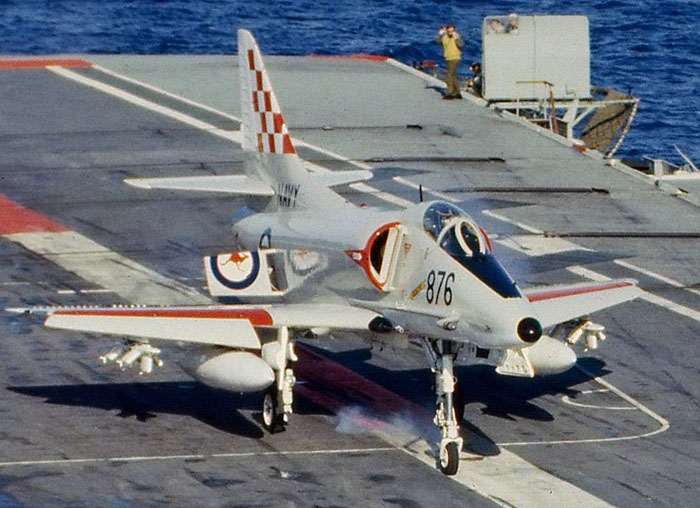
An A4 Skyhawk lands on Melbourne in the late 1970s
At first, HMS Melbourne was scheduled to carry an Aircraft capacity of 52 piston-engine types between the deck and hangar, with the British types that existed at the time, such as the Firefly multirole attacker, ASW avenger and Seafire or Sea Fury fighter bomber. In the hangar alone she could carry 24 aircraft (potentially Sea Fury, Firefly, Gannet and Sea Otter as rescue amphibians).
Needless to say after 1955 all these models were already obsolete and retired from service.
Instead, the air group was revised with more capable but heavier models, down to 28 at best:
-In 1956 she carried eight Sea Venom FAW.53 jets as fighters, and 17 turboprop ASW patrollers Fairey Gannet AS.1 as well as two Sycamore HR.50 for SAR and liaison.
-In 1963, she carried 10 Sea Venom, 10 Gannet AS.1 but eight Wessex HAS.31 to take amphibian assault roles (Malaya insurgency).
-In 1975-80 she operated 8 A-4G Skyhawk and 4-6 S-2E Tracker and 10 Wessex HAS.31B (from 1980 five Sea King HAS.50). This choice reflected a new swap back to ASW patrols.

Australian A4G skyhawk, VF-805, Melbourne 1980
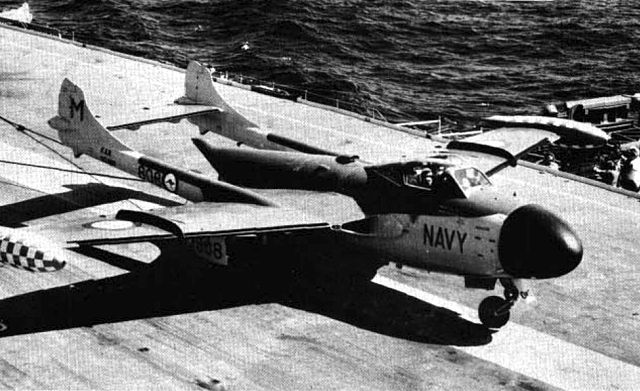
Sea Venom of 805 NAS catapulted 1962

Grumman S2G tracker landing, 1970s
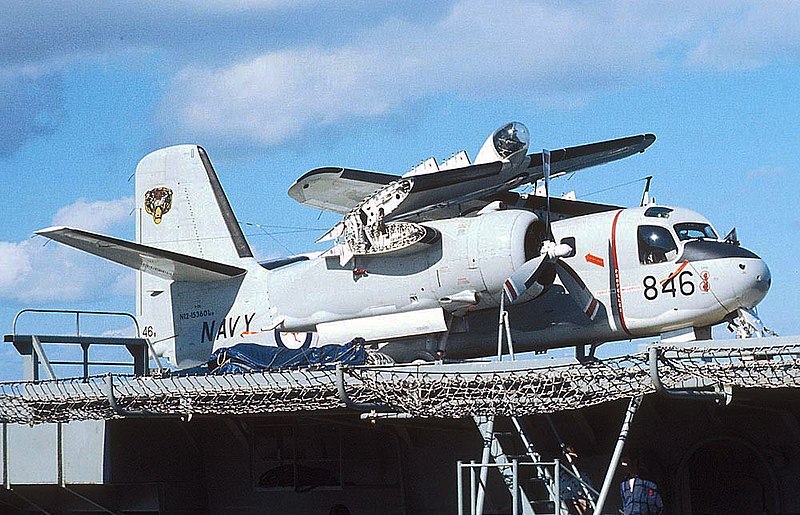
Closeup of the same catapulted
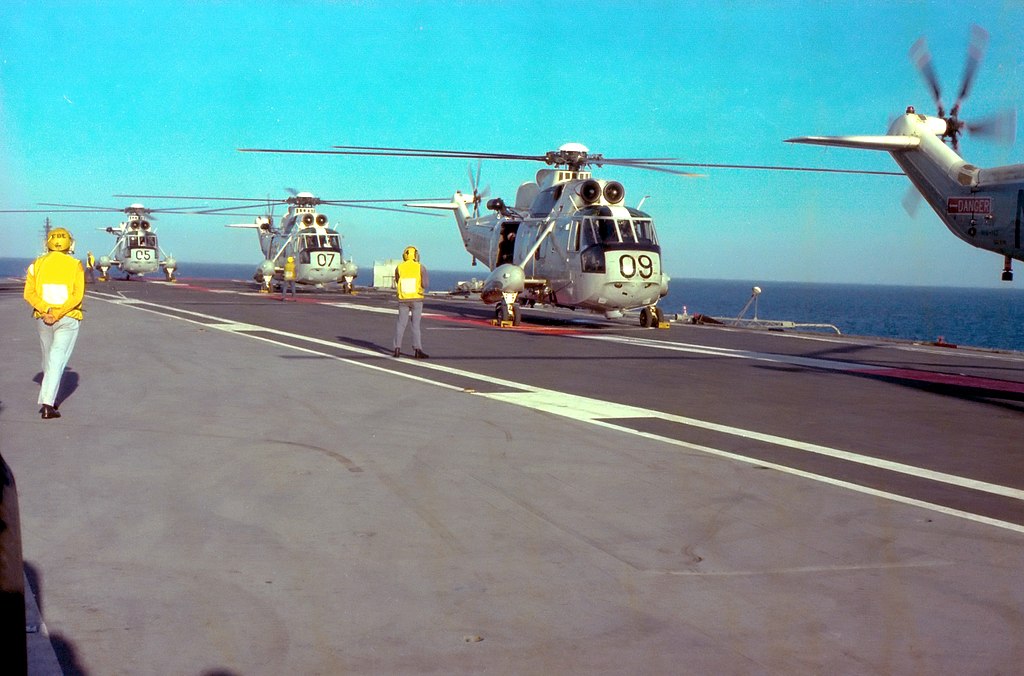
Sea Kings aboard Melbourne in 1980. She was the last ASW carrier in these waters.
⚙ Sydney 1948 specifications |
|
| Displacement | 15,740 tons st. 19,550 tons FL (14,380 tons/19,550 tons transport) |
| Dimensions | 630 ft pp, 698 ft oa x 80 ft x 25 ft |
| Propulsion | 2 shafts, 2x Parsons SRG Turbines, 4x Admiralty 3-drum boilers, 40,000 shp (30,000 kW) |
| Speed | 24.8 knots (45.9 km/h; 28.5 mph) |
| Range | Oil 3,480 tons, 12,000 nm at 14 knots |
| Armament | 30 Bofors 40 mm/L60 AA (18×1, 6×2) as completed, see notes |
| Air group | Up to 38: 12 Sea Fury fb.11 fighters, 12-22 Sirefly AS.4, see notes |
| Sensors | 2× 227Q FCS radars, single 293M, 960/281BQ, 961 radars |
| Crew | 1,100 peace, 1,300 wartime, 1,400 ad flagship |
Modifications
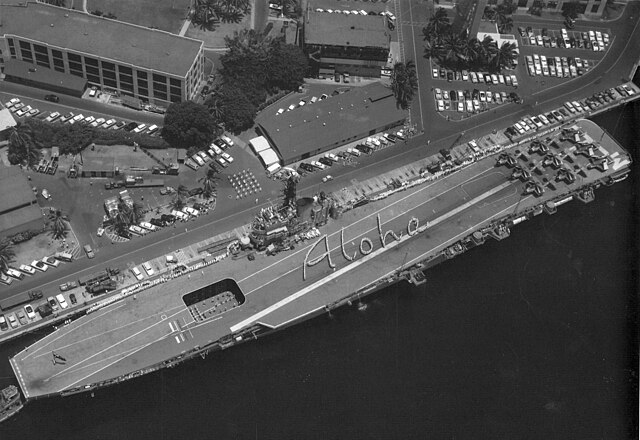
Aerial photograph taken from directly overhead of a small aircraft carrier, while she is berthed alongside a wharf. Nine aircraft are parked in a three-by-three pattern at the carrier’s stern, and personnel are positioned to spell out the word “Aloha” when seen from above.
Early on, she underwent annual refits, generall scheduled between September and January-February but they increased in duration or were alternated with true major overhauls when needed. She had one in the 1968, one in 1971 and one in 1976. Her first major one started by December 1967 until February 1969 so to be able to operate the S-2 Tracker and A-4 Skyhawk, at a cost of A$8.5 million, and she had also a complete drydock hull overhaul as well as her machinery, while the flight deck was strenghtened, as the catapult and arrestor cables. The aviation tanks were also modified for the new fuel type used and all electric wiring, electronics, sensors, systems, flight control arrangements, navigational aids, radar were also upgraded, Air conditioning installed, the water problem was solved and a liquid oxygen generation plant were installed. It was all done at Garden Island Dockyard.
The next started by 1971 and focused on the water-hungry catapult, replaced with new components from HMCS Bonaventure and USS Coral Sea. The flight deck was reinforced/strengthened further and the air conditioning system overhauled and improved. Indeed originally she was tailored to serve in the North Atlantic-Arctic and needed a tropicalized system; Still even after this upgrade, the crew suffered from higher temperatures than usual for a carrier, as over 65 °C (149 °F) with a record at 78 °C (172 °F). After seven months at A$2 million, she started sea trials from Garden Island Dockyard.
She was also drydocked from November 1972 to August 1973, again on her catapult and from April 1975 to June 1976 as a SLEP type upgrade, to extend her operational life to 1985. The refit was completed by a second tranche between late 1978 until August 1979. The one due for late 1981 was postponed and cancelled in January 1982 as the government decided to have her decommissioned, acquiring instead the smaller HMS Invincible. The main argument was over maintenance and operations, crew costs. She had up to 1,417 officers and ratings as flagship, whereas Invincible had c900 at the time due to her more modest air group.
Read More
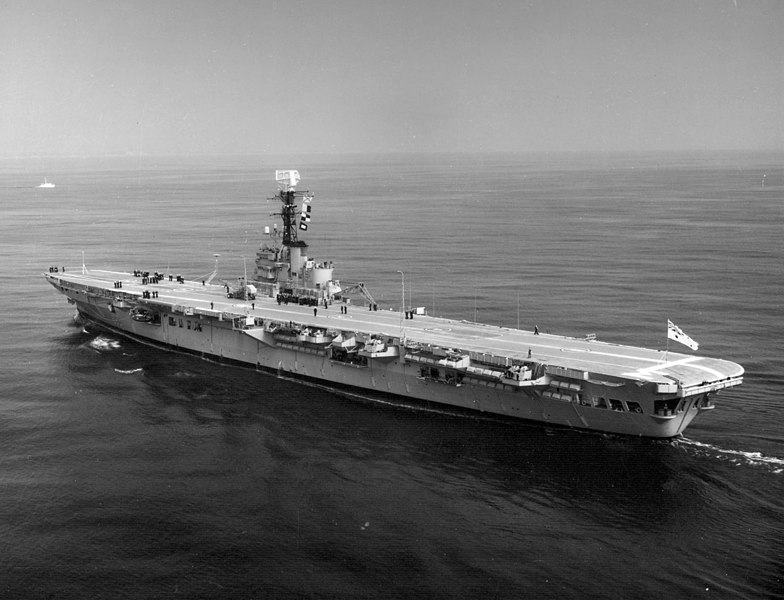
Underway in 1967
Books
Conway’s all the world’s fighting ships 1947-95
Australian Naval Aviation Museum (ANAM) (1998). Flying Stations: a story of Australian naval aviation. St Leonards, NSW: Allen & Unwin.
Bastock, John (1975). Australia’s Ships of War. Cremorne, NSW: Angus and Robertson.
Bishop, Chris; Chant, Christopher (2004). Aircraft Carriers: the world’s greatest naval vessels and their aircraft. London: MBI
Cassells, Vic (2000). The Capital Ships: their battles and their badges. East Roseville, NSW: Simon & Schuster.
Coulthard-Clark, Chris (1999). Breaking free: transformation of Australia’s defense industries. Australian Scholarly Publishing.
Donohue, Hector (October 1996). From Empire Defence to the Long Haul: post-war defence policy and its impact on naval force structure planning 1945–1955. Papers in Australian Maritime Affairs (No. 1). Canberra: Sea Power Centre.
Frame, Tom (1992). Pacific Partners: a history of Australian-American naval relations. Rydalmere, NSW: Hodder & Stoughton.
Frame, Tom (2004). No Pleasure Cruise: the story of the Royal Australian Navy. Crows Nest, NSW: Allen & Unwin.
Frame, Tom (2005). The Cruel Legacy: the HMAS Voyager tragedy. Crows Nest, NSW: Allen & Unwin.
Gillett, Ross (1980). HMAS Melbourne – 25 Years. Sydney, NSW: Nautical Press.
Gillett, Ross (1988). Australian and New Zealand Warships since 1946. Brookvale, NSW: Child & Associates.
Grey, Jeffrey (1998). Up Top: the Royal Australian Navy and Southeast Asian conflicts, 1955–1972. The Official History of Australia’s Involvement in Southeast Asian Conflicts 1948–1975. St. Leonards, NSW: Allen & Unwin.
Hall, Timothy (1982). HMAS Melbourne. North Sydney, NSW: George Allen & Unwin.
Hobbs, David (2005). “HMAS Sydney (III): a symbol of Australia’s growing maritime capability”. In Stevens, David; Reeve, John (eds.). The Navy and the Nation: the influence of the Navy on modern Australia. Crows Nest, NSW: Allen & Unwin.
Jeremy, John (2005). Cockatoo Island: Sydney’s Historic Dockyard. Sydney: UNSW Press.
Lind, Lew (1986) [1982]. The Royal Australian Navy – Historic Naval Events Year by Year (2nd ed.). Frenchs Forest, NSW: Reed Books.
Nott, Rodney; Payne, Noel (2008) [1994]. The Vung Tau Ferry: HMAS Sydney and Escort Ships (4th ed.). Dural, NSW: Rosenberg.
Stevens, David; Sears, Jason; Goldrick, James; Cooper, Alastair; Jones, Peter; Spurling, Kathryn (2001). Stevens, David (ed.). The Royal Australian Navy. The Australian Centenary History of Defence (vol III). South Melbourne, VIC: Oxford University Press.
Wilson, Stewart (1993). Phantom, Hornet and Skyhawk in Australian Service. Canberra: Aerospace Publications.
Wright, Anthony (June 1998) [1978]. Australian Carrier Decisions: the acquisition of HMA Ships Albatross, Sydney and Melbourne. Papers in Australian Maritime Affairs (No. 4). Canberra: Sea Power Centre.
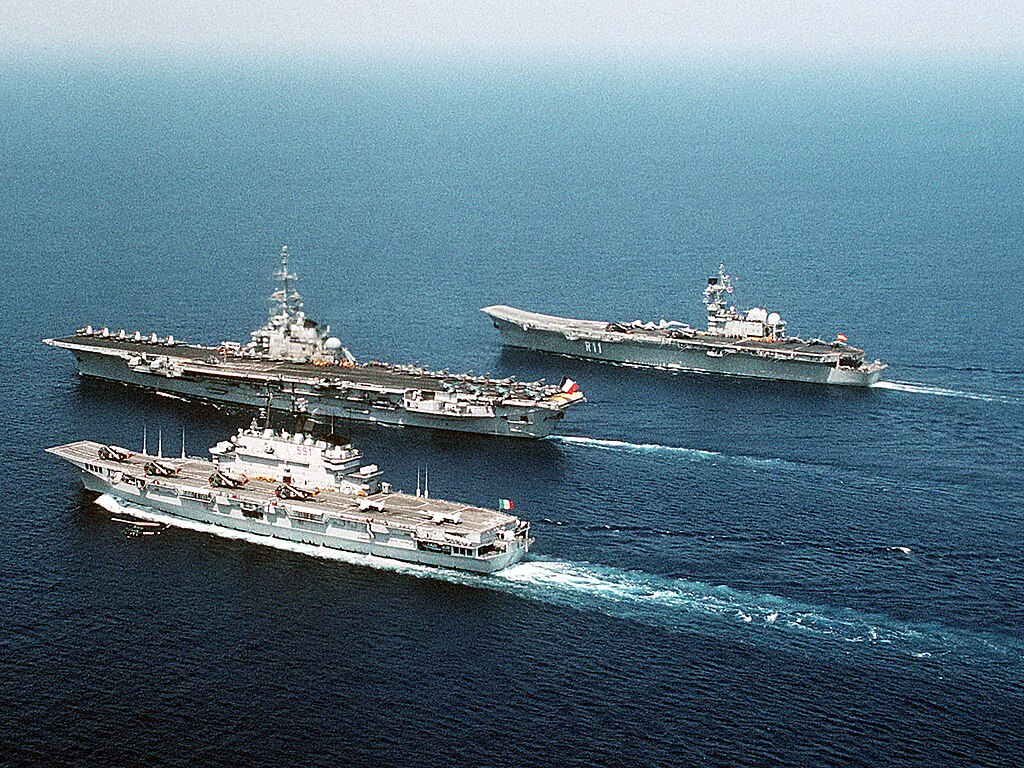
To replace Melbourne many options were considered already in the 1960s: Another modernized British carrier, HMS Hermes, in 1982 HMS Victorious, an Essex class ship, or in 1980 the Garibaldi and Astrurias in construction at the time (here, with Foch). Without proper budget the new government cut funding for it. Naval Air Operation today are conducted mainly from NAS HMAS Albatross. The new LHDs of the Camberra class are in fact the replacement from 2014, long overdue.
Links
navypedia.org/ aus_cv_melbourne.htm
commons.wikimedia.org HMAS_Melbourne_(R21)
navy.gov.au/hmas-melbourne-ii
en.wikipedia.org/ HMAS_Melbourne_(R21)
navalmarinearchive.com steam_catapults.html
web.archive.org www.navy.gov.au/HMAS_Melbourne_(II)
web.archive.org/ R21 Service.htm
Videos
See also https://youtu.be/xcfZAid8mrg
Model Kits
Imperial Hobby Productions 1:700. That’s the only one, but any colossus/majestic at any scale would do with some scratch.
Related query on scalemates
HMAS Melbourne in service
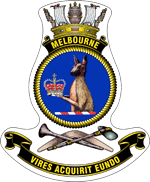 Commissioned in 1955, HMAS Majestic became Melbourne two days later with her full Australian crew coming with HMAS Vengeance. She had a working-up time in British waters, before departing Glasgow on 11 March 1956 for her maiden voyage to Australia via Suez and the Indian Ocean. She ferried 64 aircraft (RAN squadrons 808, 816, and 817) packed on deck and hangar, the largest “air group” she ever had. She was escorted for a time by the racing yacht Samuel Pepys, gift to the RAN Sailing Association from the Royal Navy. She stopped en route to Gibraltar, Naples, Malta, Port Said, Aden, and Colombo, and dropped anchor at Fremantle on 24 April 1956. Sailing east she met HMAS Sydney near Kangaroo Island, visited her namesake vity and Jervis Bay, and then was offloaded of her planes at NAS HMAS Albatross untile resuming trip to Sydney on 10 May. She became flagship in place of Sydney followed by a refit for machinery inspection and fixes after her shakedown. Next until November she sailed to Southeast Asian waters for Exercise Albatross, and in the Philippines hosted Pdt. Ramon Magsaysay. She was in Melbourne for the 1956 Olympics, sending 200 of her crew to participate as staff.
Commissioned in 1955, HMAS Majestic became Melbourne two days later with her full Australian crew coming with HMAS Vengeance. She had a working-up time in British waters, before departing Glasgow on 11 March 1956 for her maiden voyage to Australia via Suez and the Indian Ocean. She ferried 64 aircraft (RAN squadrons 808, 816, and 817) packed on deck and hangar, the largest “air group” she ever had. She was escorted for a time by the racing yacht Samuel Pepys, gift to the RAN Sailing Association from the Royal Navy. She stopped en route to Gibraltar, Naples, Malta, Port Said, Aden, and Colombo, and dropped anchor at Fremantle on 24 April 1956. Sailing east she met HMAS Sydney near Kangaroo Island, visited her namesake vity and Jervis Bay, and then was offloaded of her planes at NAS HMAS Albatross untile resuming trip to Sydney on 10 May. She became flagship in place of Sydney followed by a refit for machinery inspection and fixes after her shakedown. Next until November she sailed to Southeast Asian waters for Exercise Albatross, and in the Philippines hosted Pdt. Ramon Magsaysay. She was in Melbourne for the 1956 Olympics, sending 200 of her crew to participate as staff.
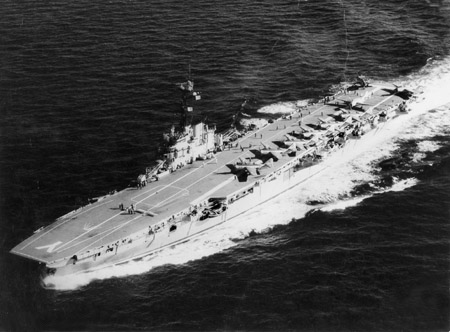 In February 1957, she was at the Royal Hobart Regatta. Off New Zealand she had exercizes with HMNZS Royalist plus ports visited followed by the first of her three-month deployments to Southeast Asia (Far East Strategic Reserv) from April-June with HMAS Melbourne back to Darwin late June. She was open to public in Port Adelaide on 28 October 1957, having the first of many minor collisions in her career. Next was Exercise Astrolabe off Lord Howe Island and both ANZAC navies. She was in Sydney for 13 December R&R new year’s leave.
In February 1957, she was at the Royal Hobart Regatta. Off New Zealand she had exercizes with HMNZS Royalist plus ports visited followed by the first of her three-month deployments to Southeast Asia (Far East Strategic Reserv) from April-June with HMAS Melbourne back to Darwin late June. She was open to public in Port Adelaide on 28 October 1957, having the first of many minor collisions in her career. Next was Exercise Astrolabe off Lord Howe Island and both ANZAC navies. She was in Sydney for 13 December R&R new year’s leave.
February-July 1958 saw her in a 25,000-nautical-mile (46,000 km; 29,000 mi) flag-showing cruise with four inter-fleet exercises. She stopped at Singapore, Hong Kong, Manila, Japan, Pearl Harbor and Fiji and had a short refit when back. In Port Phillip she was displayed to Australian Army and RAAF officer cadets. In 1959 in Sydney she was in the movie “On The Beach” followed by an exercise off the coast and Far East Strategic Reserve deployment in March-May, the ports visits.
In 1960, she lost four Sea Venoms, two Gannets in separate incidents due mostly to aircrew errors. After visiting Adelaide, she sailed for a Strategic Reserve (SR) deployment April-June, and exercises until September. In the 1961 SR she visited Bombay, Karachi, Trincomalee. She was back home in June, was at a ceremonial in Sydney Harbour for the 50th anniversary of the RAN. She took part in the Exercise Tuckerbox in the Coral Sea and toured New Zealand.
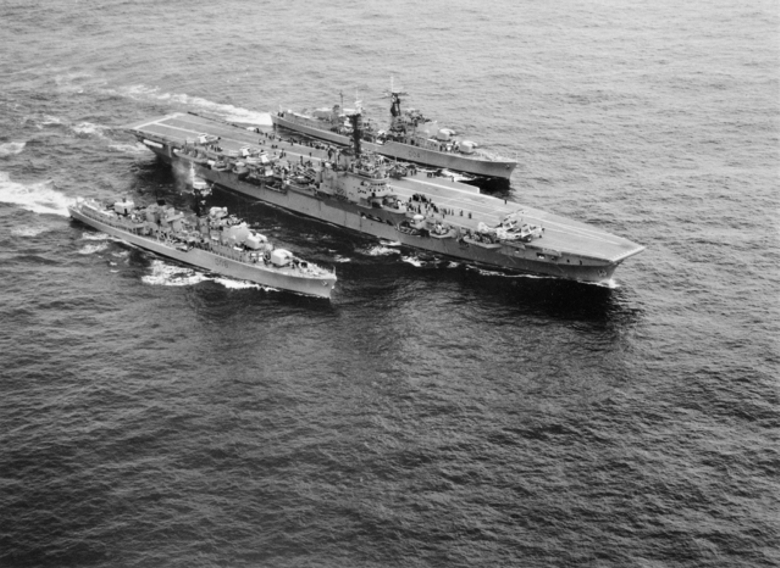
Melbourne, Voyager (which she sank later) and Vendetta in 1959
In 1962, she took part in the Royal Hobart Regatta, and departed Fremantle for her SR deployment, after which she visited Japan, Guam, and Manus Island. By September, she took part in Tuckerbox II making her 10,000th catapult launch by late 1962. She started a refit in Sydney on 1 October. In 1963, same Royal Hobart Regatta and SR routine, SEATO Exercise Sea Serpent then she celebrated her 20,000th landing in April. By September, she took part in Exercise Carbine near Hervey Bay in Queensland.
On 10 February 1964, while under trials in Jervis Bay (Captain John Robertson) post-refit the Daring-class destroyer HMAS Voyager making her own trials (Captain Duncan Stevens) started interactions with the carrier and while night-flying exercises commenced, Voyager became her plane guard escort, maintening a 20° position off the carrier’s port quarter, at 1,500-2,000 yards (1,400 to 1,800 m). At 8:40 pm Voyager was starboard of Melbourne and at 8:52 pm, turning away from Melbourne in a large circle to cross behind her and take position port. But instead she at first turned to starboard away from Melbourne and to port without warning. Aboard Melbourne spotters assumed the destroyer made tight turns to lost speed before circling behind, but to their horror she did not alter course again until at 8:55 the navigator ordered the machines half astern speed, warning captain Robertson which rushed on deck and ordered an increase to full astern. Meanwhile captain realized the situation and ordered full ahead both engines, hard starboard and a collision warning. This was too late and collision happened at 8:56 pm.
The prow of hit Voyager’s hull aft of her bridge at full force. The prow’s momentum, right amidship was suffucient not to break the hull, but simply roll over it until pressure separated the hull in two. Voyager’s forward boiler exploded but fire in the bow was extinguished by rushing seawater. Her forward section disappeared by the aft section floated for 30 min. sinking after midnight. Sydney’s HQ was scrambled to send assistance, while Sydney launched her boats to rescue the crew, preparing her wardroom and C Hangar for casualties. At 9:58 pm she was informed of the arrival of HMAS Creswell and helicopters from HMAS Albatross as well as several Ton-class minesweepers. Meanwile Captain Robertson ordered a survey of her own damage, reporting her bow has been torn off and there was a lot of scorched plating.
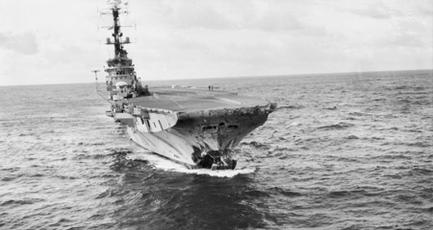 Melbourne en route to Sydney, immediately after the collision with HMAS Voyager. The damage to the bow can be seen. It was mushed after the pressure. This tragedy repeated itself during an exercize, this time with the USN, and the destroyer survived, albeit cut in half.
Melbourne en route to Sydney, immediately after the collision with HMAS Voyager. The damage to the bow can be seen. It was mushed after the pressure. This tragedy repeated itself during an exercize, this time with the USN, and the destroyer survived, albeit cut in half.
Melbourne arrived in Sydney with survivors on 14 February, at first for repairs at Garden Island, then Cockatoo Dockyard on 25 March with the whole bow cut away and repaired in drydock, after the delivery of a 40-ton prefabricated bow. This was over on 27 April. Meawnhile a ceremony was helf for the remaining crew of Voyager. Out of 314 aboard, 14 officers, 67 sailors, one civilian dockyard worker were killed and the captain as all but two on the bridge. They drawned as the ship rolled over completely, practically pushed under the carrier’s hull. The Royal Commission held in 1964 concluded that the destroyer was primarily at fault for neglecting proper lookout awareness but also blamed lookouts on Melbourne’s bridge for failing to alert Voyager, not taking collision avoidance measures sooner. Robertson was demoted to HMAS Watson but her resigned from the Navy. After much media pressure a second Royal Commission was opened in 1967, finding that Stevens was medically unfit for command. Later Robertson and the other officers were absolved of blame.
![]()
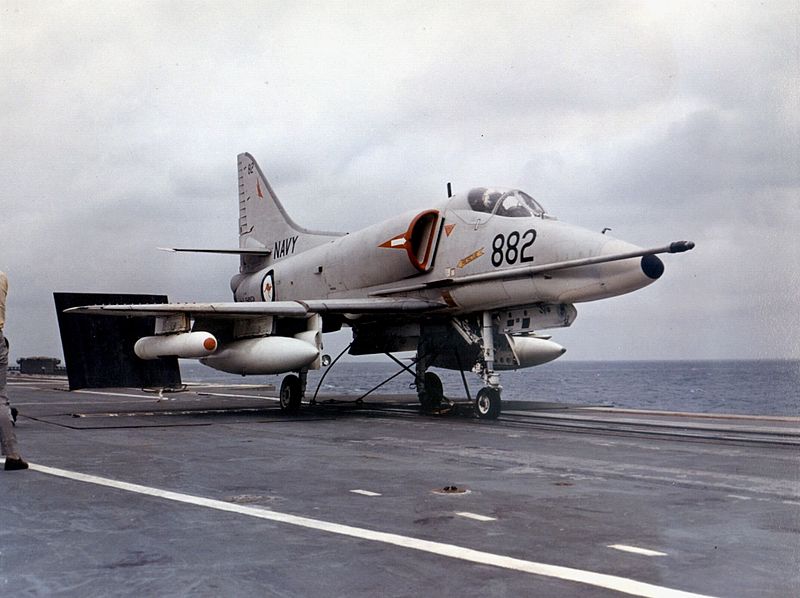
S-2 Tracker and A4G Skyhawk after adoption by Melbourne in the 1970s.
From Cockatoo she returned to SR deployments in Southeast until September 1964 and received in Subic Bay its S-2 trackers, performing flight deck trials qualifications as well as ASW drills and A-4 Skyhawk qualifications in turn. Only minor modification were needed to operate them. This led the Australian Government to approve purchase of both to modernize the air group.
From March 1965 up to mid-1967, she multiplied SR in Southeast Asia and drills or port visits and soon she was implicated in the Indonesia–Malaysia confrontation, making a show of force eoff the coast of Malaysia. She escorted her sister ship HMAS Sydney acting as troop transport, to Vietnam. Each voyage left Melbourne out of a direct participation in the conflict. She never ventured to Vũng Tàu. Instead the RAN knowing she had been optimized for ASW warfare, proposed her to the USN 7th fleet which had a hard time tracking soviet subs in the area.
This was suggested by March 1966 for Yankee Station, but Melbourne only made a 10 deployment on side, when rotating deployments were setup with US carriers, and nothing came out of the plan. It was suggested to use her to support Austrlian troops as assault helicopter base, but she only had ten Wessex and needed modifications, deemed prohibitive, as she would needed also two escorts at the time the RAN was already hard pressed to escort Sydney.
In September 1967, she sailed to the US to gather its 14 Trackers and 10 Skyhawks. She had back home a refit in Sydney, from December 1967. By May it was suggested pilots were moved to an USMC Skyhawk squadron in South Vietnam to gain experience. But this was cancelled. Melbourne returned to service by 14 February 1969 and after sea trials until 5 May, she sailed for Subic Bay for SEATO Exercise Sea Spirit. This is when she experience her second major collision.

Melbourne–Evans collision: The FRAM destroyer aft half could be seen. The stern is floating in calm water. Two warships are close by, one to the right of frame, the other behind and partially obscured by the floating stern, and two helicopters are flying overhead in search of possible survivors.
Melbourne’s Captain John Phillip Stevenson was accompanied for this by Rear Admiral John Crabb, Flag Officer of the RAN, and she was assigned five escorts, USS Everett F. Larson, Frank E. Evans, and James E. Kyes, but also HMNZS Blackpool, and HMS Cleopatra. The captain held a dinner for their captains at the start ad narrated about the Melbourne–Voyager collision to warn about inertia of his carrier and the need for extra caution when manoeuvering near. Thus was compounded by Admiral Crabb about repositioning manoeuvres especially at night. Despite of this, she had a near-miss in the early hours of 31 May, when Larson was ordered to take in turn plane guard station.
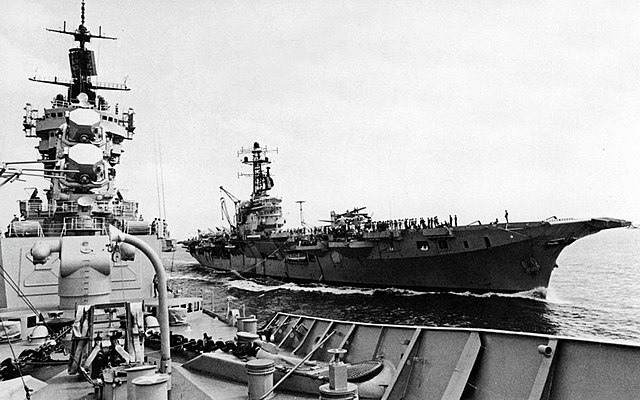
Melbourne and USS Chicago (CG-11) in 1979
On the night of 2–3 June 1969, there was an ASW training exercise in the South China Sea and the carrier before launching a Tracker, ordered USS Evans to take plane guard station and reminded the captain about her own course, instructed navigational lights to full brilliance. Evans performed alread the manoeuvre four times and started to turn starboard towards the carrier too soon. She was reminded by radio message to the bridge and CiC of the possible collision course, Evans acknowledged it but took apparently no action so Stevenson ordered hard to port and signaled the turn by radio and siren blasts while Evans turned hard to starboard to avoid her and narrowly passed in front of Melbourne but this placed USS Evans back in her path and she was hit amidships at 3:15 am, again, cut in two.
74 out of 273 were killed in the collision, asleep/trapped inside the bow which sank quickly. The aft section survived. The carrier deployed her boats, life rafts and lifebuoys approaching carefully from the stern of Evans, mooring lines were exchanged. Sailors from Melbourne dived into the water to rescue overboard survivors, and helicopters collected the remaining ones. In 30 minutes all were rescued and search went on for 15 hours. The stern section was later towed away to avoid damage, cast off, stripped for parts, sunk as target.
Following this, Melbourne had drydock repairs to her bow at Singapore from 6-27 June completed in Sydney from 9 July at Cockatoo, with the installation of a new bow section again, in September and then until 11 October due to labour disputes.
The Joint RAN-USN board of inquiry in June-July 1969 found Evans partially at fault but also Melbourne to not taking evasive action sooner although this contradicted international sea regulations which obliged the larger ship to maintain course. It was learned that Evans’ captain was asleep when it happened, so Lieutenants Ronald Ramsey and James Hopson were blamed, both inexperienced. Three USN officers and Stevenson aboard Melbourne were court-martialled for negligence but the latter was “Honourably Acquitted”. Despite this, her was demoted as minor flag officer’s chief of staff, and he resigned while the medias accused the Navy of scapegoating. Still alive by December 2012, Stevenson received an official apology by the MoD.
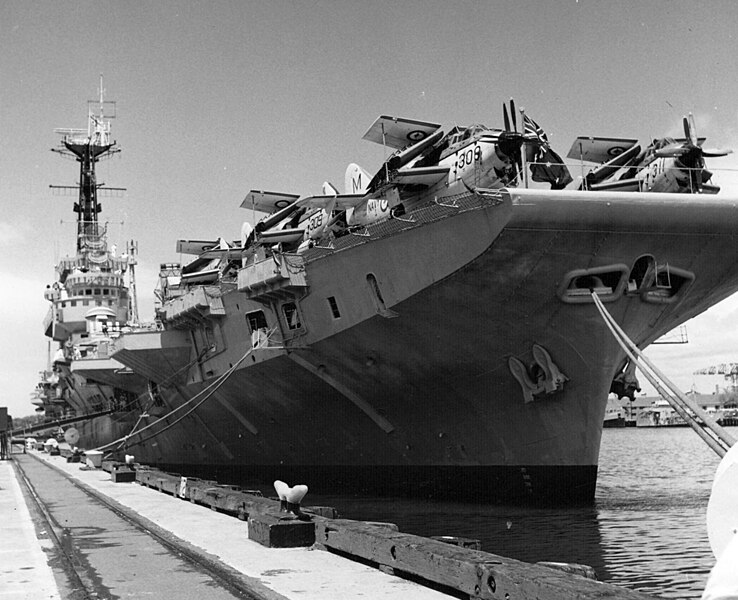
Melbourne in Pearl Harbor 1958
The 1970s-1980s, saw the carrier more often in repairs with a lack of spare parts and generally worn out. All the companies that manufactired the parts back in WW2 went out of business and replacements were made from scratch, which was costly, lenghty and inneficient. The catapult was replaced with parts from HMCS Bonaventure decom. in 1970 for example.
In 1970, the carrier took part in Sea Rover (SEATO, South China Sea), Bersatu Padu with Commonwealth forces (Malaysia) and Swan Lake with RN/RNZN off Western Australia. She visited Japan for Expo ’70, collided again by the Manly ferry South Steyne while at Garden Island. In 1971 she was in refits and in September the Joint Planning Committee considered to convert her as transport to evacuate the Australian Task Force from Vietnam. Navy opposed it as she would be missing several major multi-national exercises. They prevailed and she took part to RIMPAC 71.
After her 3 months 1972 SR to Southeast Asia, eading a coalition of 17 ships (RAN, RN, RNZN, US Navy, Philippine Navy, Royal Thai Navy) for Exercise Sea Hawk. After port visits she was in Sydney by April and trained off New South Wales coast, and later RIMPAC 72, then made an official visit to Japan and took part in a SEATO drill. A fire broke out in her main switchboard so she rushed back to Australia for a new 7 months refit.
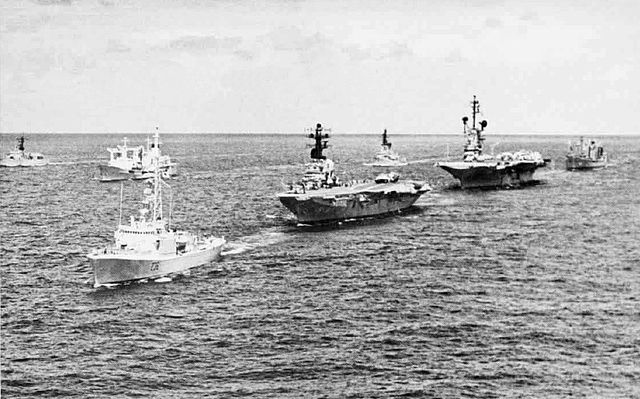
Underway at RIMPAC 1972
n 24 August 1973, she was back in Hawaii for RIMPAC 73 and back home in October, then took part in an Exercise off Malaysia. In 1974 she carried 120 Australian soldiers to train with a US battalion in Hawaii. She went to San Francisco to collect 12 Chinook, 5 UH-1 Iroquois for the RAN. By June she was in Exercise Kangaroo in the Coral Sea. On 11 July she was pushed by the passenger liner SS Australis in Sydney Harbour. After repairs she took part in disaster relief exercises, put to good use by 24–25 December 1974 after Cyclone Tracy on Darwin (Operation Navy Help Darwin). Melbourne’s seven Wessex helicopters and crew were put to good use, performing 2,493 flights, 7,824 evacuations and ferrying 107 tons of cargo.
Next she took part in RIMPAC 75, followed by a 14-month refit. On 24 July she was hit by the Japanese cargo ship Blue Andromeda. October 1976 saw her in Exercise Kangaroo II.
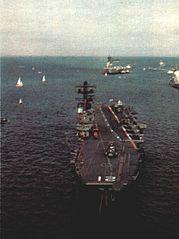 On 5 December 1976, a crew member set a fire at HMAS Albatross which destroyed all but one S-2 Trackers. So after RIMPAC 77, Melbourne sailed to San Diego to collect replacements and was back on 5 April. She started a 5 month cruise to Europe, visiting UK on 28 April with HMAS Brisbane and HMNZS Canterbury. She lost a Sea King in the Indian Ocean on 9 May. She visited Crete, a first since June 1941, landing two Bofors, donated for the Australian War Memorial at Stavromenos, Rethymno. She was oresent at the Silver Jubilee Spithead Naval Review on 28 June 1977 (photo). One Harrier made trial takeoffs and landings on 30 June to promote their adoption. She took part in Exercise Highwood in July and sailed back to Australia, Fremantle, 19 September, Sydney 4 October, docked at Garden Island until January 1978.
On 5 December 1976, a crew member set a fire at HMAS Albatross which destroyed all but one S-2 Trackers. So after RIMPAC 77, Melbourne sailed to San Diego to collect replacements and was back on 5 April. She started a 5 month cruise to Europe, visiting UK on 28 April with HMAS Brisbane and HMNZS Canterbury. She lost a Sea King in the Indian Ocean on 9 May. She visited Crete, a first since June 1941, landing two Bofors, donated for the Australian War Memorial at Stavromenos, Rethymno. She was oresent at the Silver Jubilee Spithead Naval Review on 28 June 1977 (photo). One Harrier made trial takeoffs and landings on 30 June to promote their adoption. She took part in Exercise Highwood in July and sailed back to Australia, Fremantle, 19 September, Sydney 4 October, docked at Garden Island until January 1978.
March 1978 saw her sailing for RIMPAC 78, called “Little M” by US sailors as she trained with “Big E” (USS Enterprise) as these were the largest and smallest carriers in operation at the time.
On return in July, she had a new refit until 3 August 1979 during which she had a boiler explosion. Later she took part in exercises Tasmanex, Sea Eagle I and Kangaroo III but During the first, she lost her LW-02 radar aerial which fell overboard as a Skyhawk in heavy seas. February-March 1980 saw her in RIMPAC 80, as flagship, Battle Group 2. She visited the Solomon Islands in early April and back to Sydney until mid-August for the 25th anniversary her service. Next she was in Exercise Sandgroper 80 with HMAS Perth, Derwent, Stalwart, Supply, Otama in the Indian Ocean, loosing two Skyhawks in October. On the 24th Tracker took photos of the Storozhevoy and Ivan Rogov which were shadowing the squadron. She was back in November 1980, spending time in Australian waters, and RS in Southeast Asia. In June 1981 she rescued 99 Vietnamese refugees. She took part in exercises Sea Hawk and Kangaroo 81. While at Garden Island in December, she was flooded by an officer impatient to commence leave, failing to deactivate the water pumps. 180 tons had to be pumped out the next day.
At that stage, the naval staff contemplated her replacement as incidents multiplied and maintenance was near impossible (cost A$25 million yeary). Many options were envisioned, like purchasing the already existing Italian Giuseppe Garibaldi in construction (launched 1983), a sister ship or Príncipe de Asturias herself, and possibly a former Iwo Jima-class ship. They studied ski-jump ramp advantages also for a future air group. Ultimately HMS Invincible was chosen for a delivery planned for 1983 as the Falklands War interrupted the first negociation round.
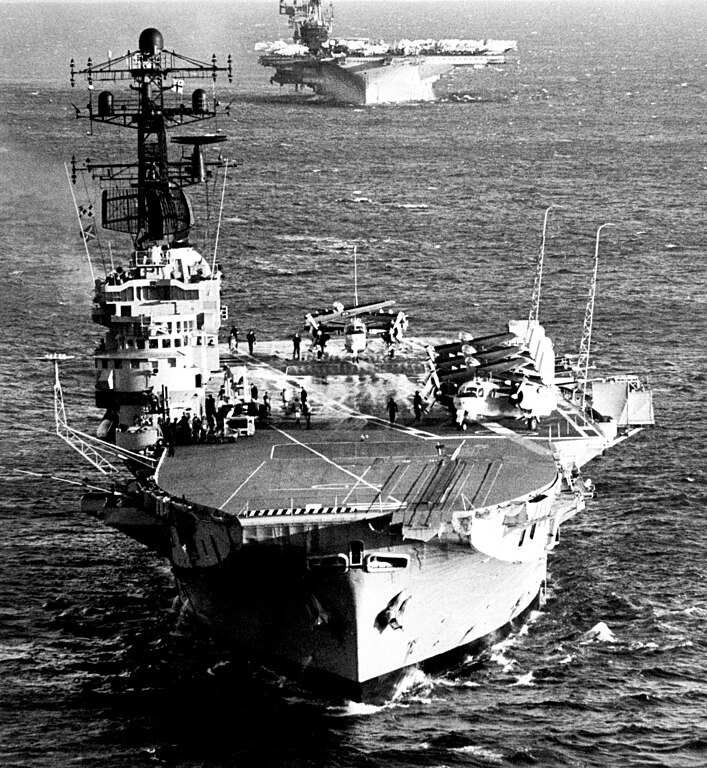
Melbourne and USS Enterprise for the last major international exercize of the former 16 May 1981
Already back in the 1960 it was envisioned to purchase HMS Albion or an Essex class ship and the staff wanted instead an helicopter carrier. In 1968, HMS Hermes took part in a combined exercise and was visited by officials, completed with RAN Skyhawks and Trackers landings and take-offs. But it was turned down due to manpower costs. June 1977 the Committee approved study of a STOVL/helicopter carrier and an Iwo Jima class was preferred.
Bu by July 1981 this changed with the British 1981 Defence White Paper which marked HMS Invincible as surplus, offered to the RAN for GB£175 million (A$285 million). This was accepted by 25 February 1982, to be renamed HMAS Australia and delaying the purchase of fixed wing aircraft. The Falklands interrupted the deal by April 1982 and ended in July. After the RAN declined HMS Hermes a request was made to provide a simple carrier to operate F/A-18 Hornets, ended wit the 1983 Australian Federal Election and decision on 14 March under Bob Hawke’s Labor Government was no replacement at all.
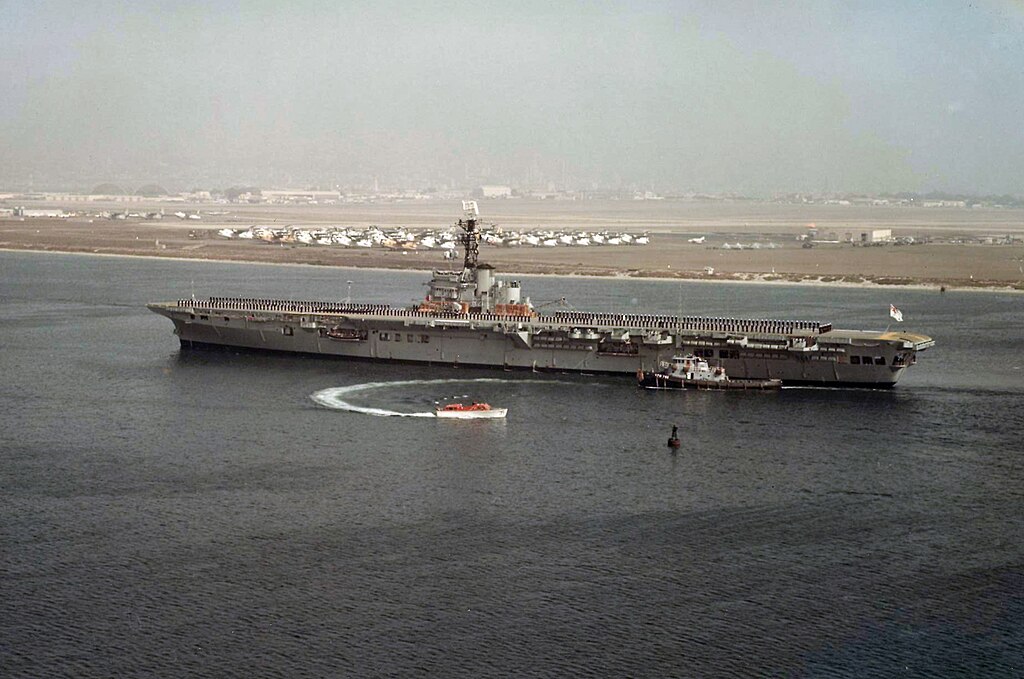
Melbourne in San Diego in the 1960s
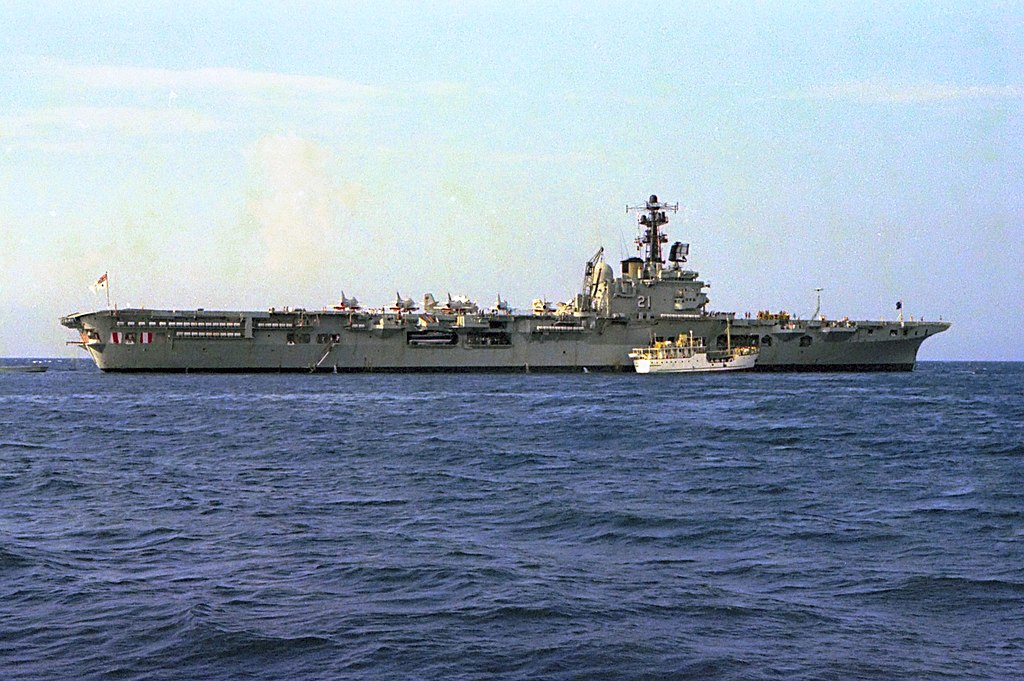
Melbourne at anchor in Honiara
The carrier was prepared for disposal, decommissioned, reserve, on 30 June 1982, towed to Bradley’s Head until 1985. In 1984 she was to be purchased and acnhored as floating casino off Eden, New South Wales. Her air wing was disbanded at HMAS Albatross, 2 July 1982, 805 Sqn Skyhawks integrated into 724 San and 816 Sqn into 851 Sqn. Trackers were withdrawn from Australian service on 31 August 1984. After a failed sell by June 1984 she was sold by February 1985 to China United Shipbuilding Co. at A$1.4 million. Before departing she was stripped of sensitive electronics, rudders welded fixed to prevent reactivation but she kept her steam catapult, arresting equipment, mirror landing system which werte avidly studied by Chinese experts, helping creating the future PLAN carrier force anyway. By 27 April 1985 was tugged by De Ping when running aground while still in Moreton Bay, freed and arrived in China on 13 June in Port Huangpu. She helped Admiral Liu Huaqing to convince the Chinese government to support a domestic aircraft carrier programme. In 2010 Melbourne was retroactively awarded “Malaysia 1965–66” as her sole “combat” deployment ever.
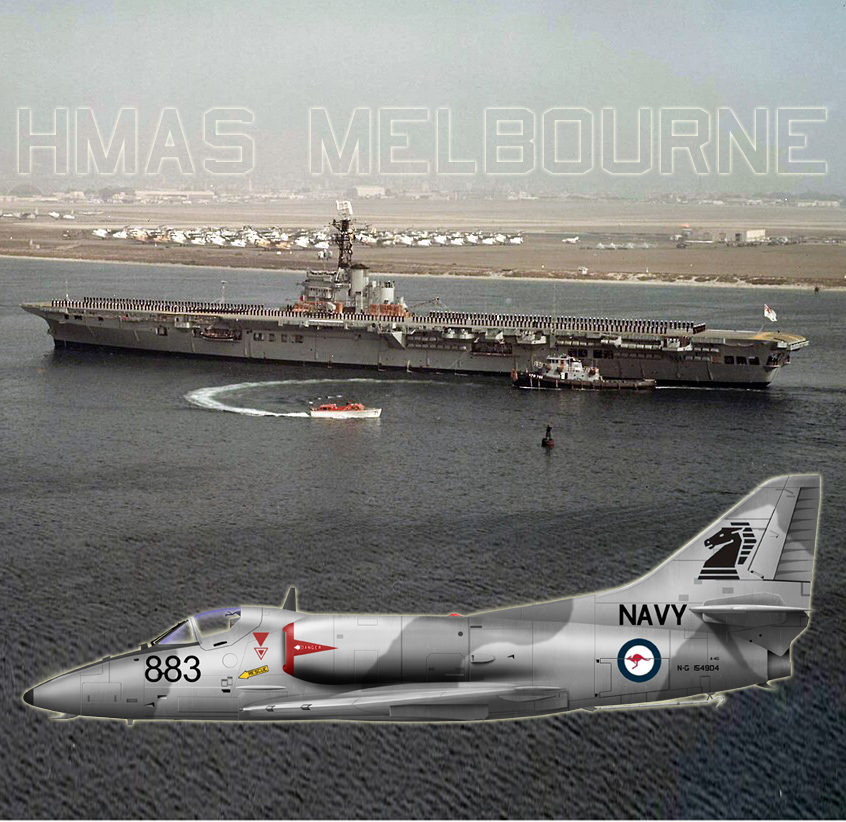

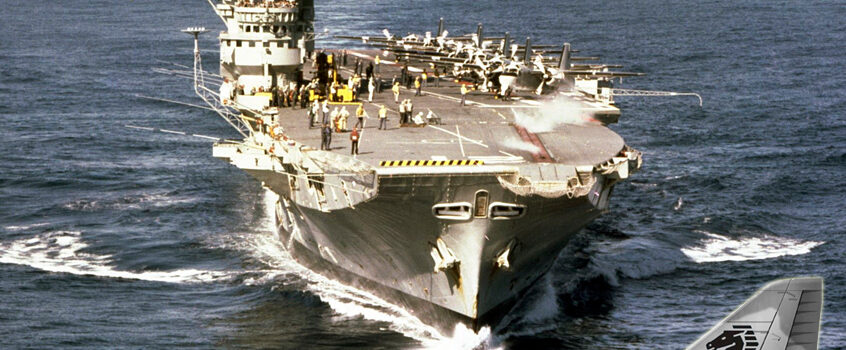
 Latest Facebook Entry -
Latest Facebook Entry -  X(Tweeter) Naval Encyclopedia's deck archive
X(Tweeter) Naval Encyclopedia's deck archive Instagram (@navalencyc)
Instagram (@navalencyc)





 Austrian Navy
Austrian Navy French Navy
French Navy Royal Navy
Royal Navy Armada Espanola
Armada Espanola K.u.K. Kriegsmarine
K.u.K. Kriegsmarine Dansk Marine
Dansk Marine Nautiko Hellenon
Nautiko Hellenon Koninklije Marine 1870
Koninklije Marine 1870 Marinha do Brasil
Marinha do Brasil Osmanlı Donanması
Osmanlı Donanması Marina Do Peru
Marina Do Peru Marinha do Portugal
Marinha do Portugal Regia Marina 1870
Regia Marina 1870 Nihhon Kaigun 1870
Nihhon Kaigun 1870 Preußische Marine 1870
Preußische Marine 1870 Russkiy Flot 1870
Russkiy Flot 1870 Svenska marinen
Svenska marinen Søværnet
Søværnet Union Navy
Union Navy Confederate Navy
Confederate Navy Armada de Argentina
Armada de Argentina Imperial Chinese Navy
Imperial Chinese Navy Marinha do Portugal
Marinha do Portugal Mexico
Mexico Kaiserliche Marine
Kaiserliche Marine 1898 US Navy
1898 US Navy Russkiy Flot
Russkiy Flot French Naval Aviation
French Naval Aviation Russian Naval Aviation
Russian Naval Aviation Sovietskiy Flot
Sovietskiy Flot Royal Canadian Navy
Royal Canadian Navy Royal Australian Navy
Royal Australian Navy RNZN Fleet
RNZN Fleet Chinese Navy 1937
Chinese Navy 1937 Kriegsmarine
Kriegsmarine Chilean Navy
Chilean Navy Danish Navy
Danish Navy Finnish Navy
Finnish Navy Hellenic Navy
Hellenic Navy Polish Navy
Polish Navy Romanian Navy
Romanian Navy Turkish Navy
Turkish Navy Royal Yugoslav Navy
Royal Yugoslav Navy Royal Thai Navy
Royal Thai Navy Minor Navies
Minor Navies Albania
Albania Austria
Austria Belgium
Belgium Columbia
Columbia Costa Rica
Costa Rica Cuba
Cuba Czechoslovakia
Czechoslovakia Dominican Republic
Dominican Republic Haiti
Haiti Hungary
Hungary Honduras
Honduras Estonia
Estonia Iceland
Iceland Eire
Eire Equador
Equador Iran
Iran Iraq
Iraq Latvia
Latvia Liberia
Liberia Lithuania
Lithuania Mandchukuo
Mandchukuo Morocco
Morocco Nicaragua
Nicaragua Persia
Persia San Salvador
San Salvador Sarawak
Sarawak Uruguay
Uruguay Venezuela
Venezuela Zanzibar
Zanzibar Warsaw Pact Navies
Warsaw Pact Navies Bulgaria
Bulgaria Hungary
Hungary

 Bundesmarine
Bundesmarine Dutch Navy
Dutch Navy Hellenic Navy
Hellenic Navy Marina Militare
Marina Militare Taiwanese Navy
Taiwanese Navy Chinese Navy
Chinese Navy Indian Navy
Indian Navy Indonesian Navy
Indonesian Navy JMSDF
JMSDF North Korean Navy
North Korean Navy Philippines Navy
Philippines Navy ROKN
ROKN IDF Navy
IDF Navy Royal New Zealand Navy
Royal New Zealand Navy Egyptian Navy
Egyptian Navy South African Navy
South African Navy

































 RN
RN
 Marine Nationale
Marine Nationale
 Soviet Navy
Soviet Navy
 dbodesign
dbodesign